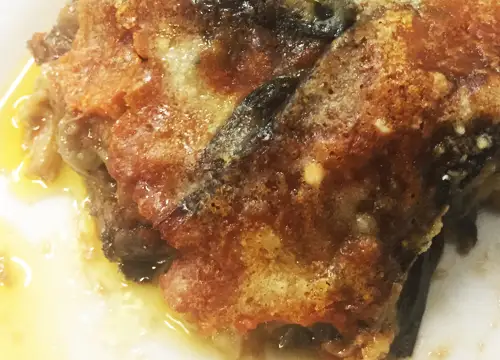Published:
Author: Antonio Maria Guerra
San Marzano Tomato PDO
THE COMPLETE GUIDE TO THE 'RED GOLD' FROM ITALY

In the Agro sarnese-nocerino area, on one of the most fertile soils of the Italian region of Campania, grows the San Marzano PDO tomato. This fruit, with its characteristic elongated shape and unmistakable flavor, is an essential ingredient in many of the most famous Neapolitan (and other) specialties, including pizza. With the help of the Consortium of its most traditional producers, we will discover the secrets of this excellent agri-food product.

What is the San Marzano Tomato?
The San Marzano Tomato is a specific type of tomato that grows in the volcanic areas around the town of San Marzano sul Sarno in the Italian region of Campania. It’s easily recognizable by its elongated, pointed shape. Its smooth, thin skin and dense flesh, with few seeds and a flavor perfectly balanced between sweetness and acidity, make it an essential ingredient in the preparation of many of the most famous Neapolitan specialties such as pizza and ragù. The great value of this fruit has been recognized by the award of the PDO mark (Protected Designation of Origin), which certifies its quality and authenticity.
San Marzano, where is it?
San Marzano sul Sarno can be rightly considered the home of San Marzano tomato. This small town, with around 10,000 inhabitants, is located in the province of the city of Salerno (Italy), in an alluvial plain not far from the Vesuvius. The surrounding area is made particularly fertile by a soil of volcanic origin and by the presence of the Sarno River that flows through it.
Read more.
If we add to this some particularly favorable climatic conditions, it should come as no surprise that this is an area particularly suited to agriculture (part of the region that the ancient Romans, emphasizing its fecundity, called ‘Campania felix’).

San Marzano Tomato: the main characteristics.
Although the San Marzano tomato is made up of a large number of varieties, each with its own specific characteristics, it is possible to identify certain common features. Among these, the most important and undoubtedly worth mentioning are:
- The elongated, pointed shape, with longitudinal depressions;
- The intense red color;
- The compact and juicy flesh with few seeds;
- The thin skin;
The volcanic soil on which it grows, together with particularly favorable climatic conditions, gives the fruit the qualities that make it so famous and appreciated: in particular, the balance between sweetness and acidity. Nor should we forget that its texture makes it particularly suitable for the preparation of preserves, sauces, and many of the most typical specialties of Italian gastronomy.

The San Marzano Tomato Plant.
The San Marzano tomato plant belongs to the Solanaceae family (which includes potatoes, eggplants, peppers, chili peppers, etc.). It is characterized by a strong trunk with numerous lateral shoots (most of which are regularly pruned) and requires supports to ensure correct vertical development (e.g. bamboo canes or metal supports). Deep green leaves provide valuable shade for the small yellow flowers that, in time, develop into clusters of fruit with the typical elongated shape.

San Marzano Tomato varieties.
Today, 32 biotypes have been registered that can be traced back to the ‘San Marzano’ tomato type. These biotypes are divided into the seven varieties currently listed in the European Register.
These seven varieties are:
- San Marzano 1, also known as ‘Kiros’;
- San Marzano 2: the ‘oldest’ variety;
- San Marzano 3;
- San Marzano 4;
- San Marzano 5;
- San Marzano ‘Dwarf’;
- San Marzano ‘Giant’;
These seven varieties are the result of a project financed by the Campania Region in 1994 to recover all the remaining populations of San Marzano tomatoes.
It should be noted, however, that only the Kiros and San Marzano 2 biotypes can be used for PDO production.
From an organoleptic point of view, while San Marzano 2 has a more pronounced aroma, Kiros has an acidity that is particularly suitable for long cooking times (such as those required for the famous ‘ragù’) and therefore for use in the kitchen.

The 20 SMEC variety: a Slow Food Presidium.
There is no hiding it: the San Marzano tomato is one of the products most closely linked to the Italian region of Campania and its gastronomic tradition. It should therefore come as no surprise that, in 2015, one of its particularly prized varieties, known as ‘20 SMEC’, became a Slow Food Presidium: an initiative aimed at protecting the ‘Ancient Tomatoes of Naples’, recognizing the quality of a delicacy characterized by an intense flavor and aromatic notes particularly rich.
Continua.
Occorre sottolineare che la lavorazione del Cioccolato di Modica non fa uso del concaggio, conservando in questo modo la consistenza granulosa originale, grazie alla quale la specialità si distingue. (Maggiori informazioni nell’articolo dedicato alla Storia del Cioccolato di Modica)


San Marzano in the Neapolitan cuisine.
There’s no point in hiding it: the San Marzano tomato has a fundamental role in the gastronomy of the Italian region of Campania in general and in Neapolitan cuisine in particular. It’s an unmissable ingredient in delicacies that have become famous all over the world. Here are just a few examples:
It’s used for the sauce that dresses the most classic Neapolitan pizzas (above all, the Margherita);
It’s, together with meat and herbs, the basis of the famous Ragù;
It accompanies the fried aubergines and mozzarella of the Parmigiana di Melanzane;
It enriches Gnocchi alla Sorrentina with an addictive flavour;
These dishes represent just the ‘tip of the iceberg’ of the recipes in which the San Marzano tomato, with its admirable balance of sweetness and acidity, is at its best.
The preparation of San Marzano in video.
This video shows how the San Marzano tomato is processed, industrially, immediately after harvesting. Acknowledgement is given to Videoinformazioni News, the YouTube channel, author of the footage.
Fascinated by the San Marzano Tomato? You will be even more so by discovering its history, told in this article.

The price of the original San Marzano.
Compared to many other types of tomatoes on the market, the San Marzano PDO tomato has a (relatively) high price. Apart from the undoubted quality aspect (which, anyway, has to be paid for), this is due to several factors. The two main ones are:
- The stringent need for careful manual workin the different stages of its production, from transplanting to harvesting: a factor that significantly increases production costs. For example, as far as harvesting is concerned, the use of machinery to detach such a delicate fruit from the plant is inadvisable.
- The area in which it can be grown: this, according to the specification, must be located in the fertile volcanic land on the slopes of Vesuvius and, obviously, is small in size. To this must be added that its yield per square metreis lower than that of many other tomatoes. As a result, its production volume ends up being lower than market demand.
Having said that, it should be noted that, in 2024, the average price of a 400 g packet of Pomodoro San Marzano dell’Agro Sarnese Nocerino DOP is, in Italy, about 1.50 Euros.

The Consortium for the Protection of the San Marzano PDO Tomato
The Consortium was officially estabilished by a Ministerial Decree in December 2003. Since then, its tasks have included protecting the product (by ensuring that the production specifications are strictly adhered to), promoting it, improving cultivation techniques and updating the list of those entitled to bear the PDO mark.
Contacts
Consorzio del Pomodoro San Marzano DOP.
Address: Via Lanzara, 27 – 84087 Sarno (Sa) – ITALY
Official website: www.consorziopomodorosanmarzanodop.it
Mail: info@consorziopomodorosanmarzanodop.it
Let’s find out how the San Marzano Tomato is born in the article we dedicated to the cultivation of this great product.
Copyright information.
The images displayed in this page belong to WebFoodCulture, with the exception of:
Creative Commons Images
- “Pomodori San Marzano” by Assianir is licensed under CC BY-SA 3.0.
- “starr-221225-5267-Solanum_lycopersicum-in_veggie_gardenin_veggie_garden_San_Marzano_variety-Hawea_Pl_Olinda-Maui” by Starr Environmental is licensed under CC BY 2.0.
- “S. Marzano Tomatoes” by florador is licensed under CC BY-NC 2.0.
- “starr-170612-9091-Solanum_lycopersicum-San_Marzano_flowers-Hawea_Pl_Olinda-Maui” by Starr Environmental is licensed under CC BY 2.0.
- “slow food” by jenny downing is licensed under CC BY 2.0.
- “Pomodoro San Marzano” by Assianir is licensed under CC BY-SA 3.0.
- “Modelli di Pomodoro” by © Musei del cibo is licensed under CC BY-SA 3.0.
- “S. Marzano Tomatoes” by Stowe Boyd is licensed under CC BY-NC 2.0.






